Pittard:
One American Family
First Generation
Samuel / Mary Newton
Second Generation
Samuel / Ann Davis
Third Generation
William / C. Louisa Meadows
Fourth Generation
Samuel L. / Margaret J. Dillard
Fifth Generation
"Bettie" / George M. Sarrett
Resources
|
|
|
|
Margaret Dillard Pittard
1836 - 1922
|
|
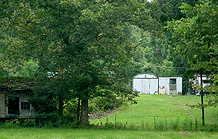 |
As 1862 drew to a close, the 40th Georgia including Samuel L. Pittard and his brother, Thomas, rushed by train to defend Vicksburg. On Dec 28, they are at the center of the Confederate line of defense at Chickasaw Bayou behind a section of Drew's battery positioned on the slight elevation of an ancient Indian mound. In 2004, the Indian mound was home to an old house trailer and utitlity buildings. Photo courtesy of Larry Crowe.
|
|
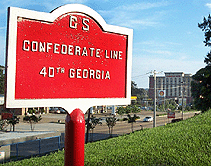 |
The 40th Georgia Infantry Regiment held the southern tip of Confederate defenses during the seige of Vicksburg in 1863. To find the "South Fort" trenches overlooking the Mississippi River, look for this red National Park Service marker from the lobby entrance of the multi-storied Ameristar Casino Hotel visible in the background. To learn more about Barton's Brigade and the 40th Georgia, visit the General Barton & Stovall History/Heritage Association. Photo courtesy of Gary R. Goodson, Sr.
|
|
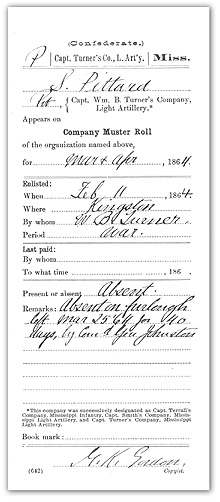 |
|
Company Muster Roll for Capt. William B. Turner's Mississippi Light Artillery for March and April 1864 shows Pvt. Sam Pittard was granted a 40-day furlough beginning March 25 by Confederate Commanding Gen. Joseph E. Johnston. The document also notes that on Feb 11 at Kingston (Bartow County, GA), Sam enlisted in Turner's Battery for the duration of the war.
|
|
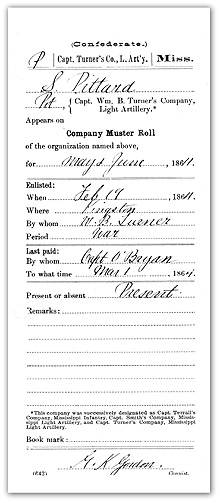 |
Company Muster Roll for Capt. Turner's Mississippi Light Artillery for May and June 1864 shows Pvt. Sam Pittard was present.
|
|
|
|
|
Cannons near the parking area at today's Cheatham Hill at Kennesaw Mountain National Battlefield Park mark the position of a section of Turner's Battery during fighting at the "dead angle" June 27, 1864.
|
|
|
| The Illinois Monument at Cheatham Hill is 370 yards south of Turner's Battery position and sits at the "dead angle" where fierce, hand-to-hand combat took place. Survivors of Col. Dan McCook's Union regiment purchased 60 acres and erected the monument on the battle's 50th anniversary in 1914. The 60 acres was the start of Kennesaw Mountain National Battlefield Park, which now covers nearly 3,000 acres. |
|
According to the following, the flag in question may have looked something like this. The banner was probably made after the war for the unit's original battery commander.
Confederate Veteran
(Vol II 1894, p.335)
J. E. LaBesse, Lake Charles, La., makes inquiry of any members of the Smith & Turner Battery, of Quitman, Miss., and adds: “I have in my possession an old flag which bears on one side the words, ‘Smith & Turner’s Battery,’ with the following battles surrounding it: Shiloh, Perryville, Belmont, Chickamauga, Resaca, New Hope Church, Jonesboro, Missionary Ridge, Kennesaw, Atlanta, Franklin, and Nashville. On the reverse is the Goddess of Liberty, with the following: ‘Our Liberty. Ready to die in its defense.’ I am desirous of corresponding with some of its members in order to ascertain the origin, etc., of this priceless relic. My wife’s father, who commanded this battery, was Col. Melanchthon Smith, now deceased.”
|
|
|
|
|
Monument on the grounds of the old courthouse in Cartersville, GA honoring Confederate soldiers was given to Bartow County by the Daughters of the Confederacy. The inscription proclaims in part that "...truth, virtue and patriotism endure forever."
|
|
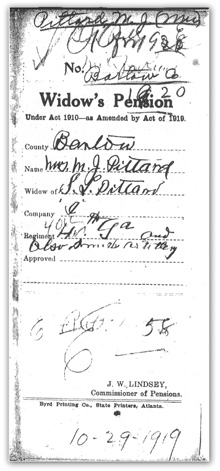 |
In 1919, our grandmother, Margaret Dillard Pittard, applied for a Widow's Pension for Sam's civil war service in both the 40th Georgia Infantry Regiment and Turner's Mississippi Light Artillery.
|
|
 |
|
Grave marker
Samuel Lafayette Pittard
Cassville Cemetery
Bartow County GA
|
|
|
Fourth Generation
Samuel LaFayette Pittard and his twin sister were born Dec 11, 1833 in Oglethorpe County GA to William Pittard and Curacy Louisa Meadows.
In the 1850 census, Samuel, age 16 and living at home, is counted among Oglethrope’s “nearly 4,500 free citizens.” Others in the Pittard household at the time include Samuel’s older brother, Thomas N., age 20, sister Elizabeth, 18, and his twin listed as Amanda. Samuel’s twin was probably named Eliza Marida rather than Amanda. Though some sources list Eliza as a separate person and the fifth and youngest child of William and Louisa, she doesn’t appear in the 1850 census when her age is placed at about 14. After the 1850 census, Amanda vanishes from the records. She could have died early. That would explain why Eliza is mentioned in William’s will while Amanda isn’t, but that fails to account for Eliza being left out of the family’s household count in 1850. The evidence points to Amanda and Eliza being one in the same; either Amanda was Eliza’s nickname or perhaps the 1850 census taker made a mistake.
In the early 1850s, Sam’s family moved to Cass (later Bartow) County GA to a farm “near White” located about four miles east of Cassville. The family of Rev. Alpen W. Buford, a Baptist minister, lived next door. The Dillard farm was nearby and soon Sam would meet their daughter, Margaret Jane. According to Margaret's Widow's Pension filed in 1919, she and Sam were married by Rev. Buford “near Cassville” on Nov 10, 1858.
*************Marriage License**************
State of Georgia, Cass County
To any ordained minister of the Gospel, Judge of the Superior Court, Justice of the Inferior Court, or Justice of the Peace. You are hereby authorized to join Samuel L. Pittard and Miss M.J. Dillard, in Lawful Bonds of Matrimony agreeable to the Laws and Constitution of this State. Given under my hand and seal of office this the 8th day of November 1858.
James W. Watts, Ordinary.
Georgia, Cass County. I hereby certify that the marriage of the persons named in the above license actually took place and was duly solemnized before me the 10th day of November, 1858.
A.W. Buford, M.G.
Recorded November 12th, 1858. James W. Watts, Ordinary.
(The following is handwritten and filed with Margaret's Widow's Pension Application.)
I certify that the above and foregoing is a true and correct copy of Marriage Record Book “E” page 148 now of file in this office. This Oct. 9th, 1919. G.W. Hendricks, Ordinary, Bartow County, GA
Sam and Margaret's first child, Martha L., was born the following fall. They called her Mattie. The families of the young couple were among the area's most prosperous and together owned 47 slaves according to the 1860 Cass County Slave Census. By then, 26-year-old Sam farmed and lived near his father, William, now a widower after Louisa died May 16, 1857. With real estate valued at $1,400 and a personal estate worth $2,900, young Sam would have been considered wealthy by his contemporaries. In the Slave Census, Sam is listed with two, a 16-year-old male and a freed 17-year-old female. They probably occupied Sam’s only “slave house,” which the separate census also recorded.
Despite the political war that divided the nation with the election of President Lincoln in the fall of 1860, most north Georgians were against a military conflict. As moderate thinkers for the times and loyal to the Union, they opposed secession by nearly two-to-one. Pro-Union Cass County delegates voted unanimously against seceding in January 1861, but on the strength of balloting by delgates from the southern part of the state, the measure passed and Georgia left the Union.
Late in 1861, Sam and Margaret welcomed their second child, a boy, William Davis, who would be known as Dave (Uncle Dave to later generations). By then Cass County had changed its name to honor a Southern soldier. Originally named for then Secretary of War, Lewis Cass of Michigan, the locals now found his position in the current political climate intensely unpopular, and the state renamed the county for Capt. Francis S. Bartow of Savannah, killed at the Battle of Manassas. Cassville also changed its name to Manassas, however, the moniker never took hold.
Early in 1862, Confederate President Jefferson Davis asks Gov. Joseph Brown for 12 regiments to defend the Southern cause. The Georgia head of state presents him with 18. Sam and his brother, Thomas, answer the call along with other young men from their community and enlist as privates. The Pittards are assigned to Company I of the 40th Regiment. Numbering 1,174 officers and soldiers from the county and nicknamed The Bartow Rangers, the men of the 40th Georgia muster in at Camp McDonald near Big Shanty (now Kennesaw) GA on Mar 4. Their commander is Col. Abda Johnson, a Cassville lawyer. The 40th and four other regiments of young men from north Georgia, the 41st, 42nd, 43rd, and 52nd, are immediately absorbed into the Confederate States Army. Before the year is out, the five regiments of the Georgia Brigade will be assigned to Gen. Seth Barton, Department of Mississippi and East Louisiana, fight in the western theatre, and become part of the Confederate Army of Tennessee.
Knoxville & East Tennessee...Mar 27, 1862...Sam and others in the Georgia Brigade officially enlist for three years and receive a $50 bounty. The next day, the men of the 40th board the train for Camp Van Dorn in Knoxville, TN. For Samuel and Thomas Pittard, the war has begun.
 |
Unveiled March 28, 2007, exactly 145 years after our grandfather, Sam Pittard, and others in the 40th Georgia Volunteer Infantry Regiment arrive at Camp Van Dorn, this Tennessee historical highway marker is the result of 10 years of research and persistent navigation of numerous state bureaucracies by Gary R. Goodson, Sr. of Shawnee, CO. Our grandfather, Sam, and Goodson's ancestor, who also served in the 40th Georgia, escaped diseases that swept through camp, killing 137 in just the 40th and 52nd regiments alone.
The marker is located "near the banks of a little stream, Third Creek" on the south side of Western Ave. in Knoxville, TN. |
|
CONFEDERATE STATES
OF AMERICA
CAMP VAN DORN
MARCH 28 - JULY 28, 1862
Major General E. Kirby Smith of the Confederate Army established Camp Van Dorn 1.5 to 2 miles west of Knoxville Depot, near the banks of a little stream, Third Creek. It operated from March 28 through July 28, 1862. Most Georgia Confederate Infantry regiments, including the 37th, 39th, 40th and 52nd from Camp McDonald at "Big Shanty", Georgia were here. Diseases decimated the ranks of the Ga. 40th and 52nd, killing 137. Most of these Confederate dead were buried in Bethel Cemetery here in Knoxville.
|
|
| Contributed by Gary R. Goodson, Sr. |
Cumberland Gap, TN/KY Border...June 17 & 18, 1862...On May 23, 1862, the 40th Georgia is ordered northwest to Cumberland Gap. They arrive before their supply wagons and must forage for food or starve. Over the next three weeks, the 40th is ordered back and forth across Tennessee, traveling both by train and on foot. Once again on the Tennessee-Kentucky border, Sam’s regiment takes part in the Battle of Cumberland Gap.
Perryville, KY...Oct 8, 1862... All summer long the men of the 40th endure scarce food supplies and unrelenting drought in the desolate mountains of Cumberland Gap. No relief came for the parched Kentucky landscape as summer faded into autumn.
Desperate to retain control of water supplied by Doctor’s Creek, the Southern army of 16,000 soldiers takes on a larger Federal force on Oct 8, 1862 in the Battle of Perryville. Sam's 40th regiment is held in reserve and never enters the battle, however, the artillery company in which he, his brother, Thomas, and two nephews serve later in the war plays a pivotal role in the outcome of the tactical Confederate victory.
Lt. William B. Turner’s Mississippi Light Artillery is attached to General George Maney’s Brigade of Tennesseeans of Major General Benjamin F. Cheatham’s division. In a fierce five-hour fight at Perryville, Maney’s men destroy an eight-gun Federal battery and flush panicked infantry into running for their lives.
Following Maney’s brigade across a stream, legend has it that Turner’s cannoneers have to pick and shovel a wide enough passage to accommodate their guns up a wagon road. At the top of the hill, Turner runs into his division commander, General Cheatham, who sends the battery’s four cannons to high ground on the battlefield’s farthest point to the right. From there, Turner reported later that he “immediately opened an enfilading fire on [Terrill’s line and Lt. Charles Parsons’ battery] at a distance of 250 to 300 yards, with canister, and continued it with shell and spherical case as the enemy retired.” Since the range of a civil war cannon was three miles, its understandable why his Union targets would later call Turner’s deadly fire that day “terrible beyond description”.
Maney’s Tennesseeans, which at Perryville also include the 41st Georgia Regiment of Sam and Tom's brigade, hurry down a gentle slope and fire from their bellies behind stone and rail fences between the guns of Turner on one hill and Parsons on the next. A member of Maney’s brigade said afterwards that “...such a storm of shell, grape and canister and minie balls was turned loose upon us as no troops scarcely ever before encountered.”
Captain Thomas H. Malone, adjutant general on General Maney’s staff at Perryville, recounted that “...our men could not have maintained our position at all but for the fact that old Turner - the best artillery man, but the poorest drilled man in the army -- was imperatively demanding the attention of Parsons' guns. He thundered with his little six-pound howitzers right over the heads of our men, and with grape was making it very hot for Parsons...”
The horrific Confederate fire kills or wounds two-thirds of Parsons’ cannoneers. However, undermanned and outgunned, Maney's only hope is that a simultaneous charge can take the Yankee guns. At the signal, 1,200 screaming men jump to their feet and run as fast as they can at Parsons. A scalding blast from the crippled Yankee gun crew tears through the assault before the Southerners overrun the Federal position without firing a shot. After a fierce clash of gun butts and bayonets, the Yankee line gives way in a panicky run for the next hill. Turner follows, taking up Parsons’ former position and renews the shelling. Now, so far forward that he risks being flanked by the enemy, General Maney regroups and holds his position.
After dark, Turner seizes all the Federal artillery his men and horses can handle and cuts up the rest. The battery is allowed to keep the captured trophies and selects the best two, which become the pride of Cheatham’s division.
One cannoneer with Turner that day is James R. Pittard, son of James H., and Samuel and Thomas’ nephew. He’s eventually promoted to corporal. Later in the war, James, his younger brother William, and Samuel and Thomas will all serve with Turner’s battery.
The South wins the day at Perryville and retains control of the water supply, though the contest costs both sides a total of 7,500 casualties.
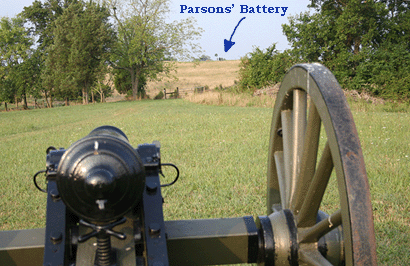 |
| View of the open hill that has become known as Parsons' Ridge, a scant 250 to 300 yards from Turner's four cannons [foreground] positioned on the extreme right of the Confederate line during the Battle of Perryville, Kentucky's biggest conflict during the war. |
|
Chickasaw Bayou near Vicksburg, MS...Dec 28 & 29, 1862... After Perryville, a portion of the Southern forces amass near Murfreesboro, TN and prepare to engage the Federals. In December, the largest Confederate division, including the 40th, rush by train deep into Mississippi to defend Vicksburg and keep the Mississippi River under Confederate control.
The 40th Georgia arrives at the Vicksburg depot at 11 a.m. Dec 27, 1862. Though fatigued from being pent up on the train for a week, the 40th along with the rest of Barton's Brigade are immediately ordered to march north, first to Mint Spring where they rest until midnight then to the Valley Road at Chickasaw Bayou, one of five possible landing sites for Union troop ships. In the center of the Confederate line of defense, a section of Drew's First Mississippi Light Artillery mans the slight elevation of an old Indian mound. In front of the Indian mound, Col. Charles H. Morrison's 31st Louisiana hunker in rifle-pits. At 4:30 a.m. on Dec 28, the Federals open fire on Morrison's men in the rifle pits and Drew's two cannon positioned on top of the Indian mound.
Early in the day, 40th Georgia Commander Col. Abda Johnson sends five companies or about 100 men to reenforce the Cajuns now under heavy fire and on the verge of being overrun. Col Morrison, commanding the 31st Louisiana, later expressed his indebtedness to the 40th "for their coolness and cheerful obedience." Two 40th Georgia companies are sent to strengthen the line of skirmishers and the remaining three companies, including Co. I and the Pittards, stay on the road. Col. Johnson of the 40th is wounded but stays at the front with his men.
The next day, Dec 29, Barton's Brigade is positioned in the center of the Southern line behind well-fortified breastworks constructed high upon bluffs known as Walnut Hills. Federal artillery and small-arms fire render it impossible for the men to stand to their guns down front on the Indian mound. With the Southern battery silenced, the fierce Union attack concentrates on the Confederate breastworks.
Taking advantage of the terrain's natural defenses, the Confederates' nearly impregnable stronghold repulses five enemy assaults. Yankee dead outnumber Southern losses more than eight to one before the Federals pull back in defeat.
Baker's Creek/Champion Hill near Vicksburg, MS...May 16, 1863
Big Black River near Vicksburg, MS...May 17, 1863
Vicksburg Seige...May 18, 1863 - July 4, 1863...As men and equipment arrive exhausted after three days of marching and fighting, officers assign them to positions in the trenches. Shot up badly at Baker's Creek/Champion Hill, Stevenson's Division, including Barton's Brigade and the 40th GA, are assigned to South Fort, the southern-most portion of the defensive line and thought to be the least vulnerable to Yankee attack from the Mississippi River. However, all sections of the line come under constant attack. Without cover from the sun and rain or relief of any kind, the men remain in the trenches for 47 days and nights.
Surrender, Parole & Exchange...July 4, 1863 - July 12, 1863...
Georgia State Guard...Aug 1863 - Feb 1864...After being paroled and exchanged, Sam is furloughed home. He is relieved of further duty in the 40th Georgia Regiment and in August enlists as a private for a six-month stint with Capt. Robert C. Saxon's Company D of the 10th Battalion Georgia Cavalry State Guard. As mounted infantry, the Bartow County unit's mission is to defend that portion of the state west of the Chattahoochee River.
Winter Camp...Feb 1864 - May 7, 1864...The Confederate army spends the winter of 1864 resting and resupplying near Dalton, GA. Nearly half of the army's battery units including Capt. William B. Turner's Mississippi Light Artillery are sent 40 miles south to near Kingston in Bartow County, where their broken down and malnourished horses recuperate on the richness of the Etowah Valley.
With his six months of State Guard service at an end, Sam enlists at Kingston Feb 11, 1864 as a private in Turner's Battery for the duration of the war. Brother Thomas follows the next week. They join nephew James R., son of their half brother James H. Pittard. The younger James, a veteran with the company since its organization in 1861, holds the rank of corporal and is possibly in charge of a gun crew. When James' younger brother William arrives, the Pittards comprise five percent of the company's manpower.
Originally the unit was designated Smith's Battery when commanded by Melancthon Smith, a West Pointer from Alabama. Later, after Smith is promoted and Turner takes over, the artillery company gradually becomes known by his name alone. Historians have dubbed it Smith-Turner's Battery.
Turner enlisted as a private in 1861 but distinguished himself early with "skill and valor"and earned his command on grit alone. His division commander, Gen. Cheatham, described him as plain, uneducated, and unqualified, but pushed hard for his promotion to captain because no qualified candidate existed.
At Kingston, Capt. Turner resupplies his company by requisitioning seven tents, 10 jackets, four shirts, three blankets, six hats, nine pairs of shoes, and 20 pairs of drawers. He also orders six mule collars and three saddle blankets.
|
|
During the winter the men build shelters for themselves and the animals, hunt rabbits for sport and to supplement the army's regular fare, undergo military inspections, and drill during the day. In the evenings, many soldiers attend preaching held in camp or at nearby churches. Anticipating the renewed fighting in the coming spring sparks a wave of revivalism both at Kingston and Dalton. Often prodded by their wives or mothers, hundreds of soldiers receive the rite of Christian baptism.
The army's artillery companies struggle with shortages in both equipment and animals, and craftsmen within the ranks often fill military needs by their own skill and ingenuity. One such artisan in Turner's Battery crafts new gun carriage trails.
Six-horse teams required to pull one canon are reduced by one and sometimes two animals, and fresh replacements arrive in poor condition. Desperate to resupply, Confederate agents seize what they need from the citizens of north Georgia. Later, during the Federal occupation, the scarcity of serviceable horses and mules causes the population to be ravaged by agents of both armies, guerilla sympathizers on both sides, and ordinary criminals simply taking advantage of the chaos.
To restore troop morale, Gen. Joseph E. Johnston, head of the Confederate Army of Tennessee, sees that back pay is caught up and the men allowed time off to go home. Records show our grandfather, Samuel Pittard, is paid on Mar 1, 1864 and receives a forty-day furlough beginning Mar 25.
A few days before Sam leaves on furlough, the troops are invited to an evening presentation of "two pantomines and one burlesque tragedy - The Pirates of the Aegean Sea" by Turner's Battery Amateurs. The next morning a blanket of deep snow prompts the legendary great snowball fight of Mar 22, 1864. Thousands of soldiers enjoy the battle, and except that snowballs substitute for bullets, the contest takes on all the characteristics of a genuine military confrontation. Bands play, flags fly, and skirmishers fan out in advance of the main attack. Cheatham's division, including Turner's Battery, and W.H. T. Walker's men pelt each other for hours.
|
Atlanta Campaign...May 7 - Sept 2, 1864...At the start of the Atlanta Campaign, four descendants of our grandfather, William Pittard, are among Turner's Battery 80-man contingent, two sons, Thomas N. and Samuel L. of Cassville, Bartow County GA, and two grandsons, James R. and William of Clarke County MS.
All four Pittards survive the war. Sam is "taken sick" in the later half of 1864 and given a medical furlough. Thomas N. and James R. are captured when the battery is overun on Compton's Hill (later renamed Shy's Hill) at the Battle of Nashville Dec 16, 1864 and imprisoned at Camp Chase in Ohio. William, only 18, is among the few remaining cannoneers of Turner's Battery when it is surrendered at Citronelle, AL on May 4, 1865.
Turner's Battery included Napoleon cannons like the one fired in this video filmed during Confederate Memorial Day observances in 2002 at Cassville Cemetery, Bartow County, GA, where Samuel and Thomas are buried.
|
Rocky Face Ridge near Dalton, GA...May 7, 1864 - May 12, 1864...Sam reports back from furlough a few days before the restart of the war for the Army of Tennessee. After five days of fighting to hold the Yankees at Rocky Face Ridge west of Dalton, the Confederates escape southward.
Resaca, GA...May 14, 1864 - May 15, 1864...The brigade of Brig. Gen. George Maney, to whom Turner's Battery is attached, anchors the extreme right of the southern line and engages the enemy on May 15 when the two lines of Southerners in front of them give way. Maney's troops also eventually fall back. At dark, the Confederates hurriedly retreat south across the Oostanaula River, torching the bridge behind them.
After the fighting, Mary Green buries soldiers of Sam's former unit, the 40th Georgia and others of the Georgia Infantry Brigade, where they fell, in her rose garden. Her family eventually donates two acres for what becomes Resaca Confederate Cemetery, one of the first dedicated to Southern soldiers.
Adairsville, GA...May 17, 1864...When the valley north of Adairsville in Bartow County proves too wide for a favorable defensive position, Johnston sends all but Cheatham’s division south to Kingston and Cassville. Desperate to slow the Union advance long enough to set up defenses at Cassville, Johnston orders Cheatham to hold his position at all cost.
Cheatham’s men entrench along both sides of the road two miles north of Adairsville. After carefully concealing the guns and sheltering the horses, Turner’s cannoneers join others of the division allowed to randomly spread out through the dense woods to rest. Late in the afternoon as the soldiers relax and start supper fires, Gen. Joseph Wheeler’s rear-guard cavalry suddenly pulls back bringing news of the Yankee’s imminent approach.
|
 Resaca Confederate Cemetery
Resaca Confederate Cemetery
|
|
In an open field near the road, skirmishers quickly fan out to defend the impressive octagonal-shaped mansion belonging to Robert Saxon, the same Robert Saxon who commanded Sam's old State Guard unit. Southern troops take cover and ready to ambush. As the Confederate’s northernmost outpost, Cheatham and Wheeler prepare to face the head of the Union army.
When the sniping begins, the Confederates swarm the octagon house and respond from every window. It makes a perfect fort. Through a steady rain, both sides bring up artillery, Turner’s Battery rolling into position behind the Ninth Tennessee Regiment. The fighting soon intensifies into a full engagement. The Yankees let out a cheer and break forward to within a few hundred yards of the Southern line. The charge includes the 24th Wisconsin and a very young Arthur MacArthur, who would win the Medal of Honor for his actions the previous November at Missionary Ridge and eventually reach the rank of lieutenant general. His son, Douglas, will become America's most famous general.
The Ninth Tennessee expects to bear the defense of Turner’s guns, trophies of the terrible price to both sides paid at Perryville. Instead, the Yanks focus on the harassing rifle fire coming from the octagon house and as night approaches, the dreaded showdown over Turner’s cannons evaporates.
After the fight, the Confederates remove their dead and wounded from the bullet-pocked and bloodied home of Capt. Robert Saxon. Sam surely feared for his own home and family just a few miles further south. The Federals planned to renew the attack on the 18th, but the Southerners quietly slip away after midnight having accomplished their mission; the Yanks were held up long enough to ensure Confederate baggage trains reached Kingston and allowed Johnston time to set a trap at Cassville.
Cassville, GA...May 17-19, 1864...While Cheatham's men at Adairsville slowed the Yankee advance, Gen. Johnston and the remaining two-thirds of his army hurry south to evacuate Cassville.
In 1864, north Georgia’s vast expanse of hilly wilderness was broken only by occasional small settlements of a few hundred citizens huddled near dusty crossroads. However, in Cass (later Bartow) County, Cassville’s significant history included leading north Georgia in population, recognition as an educational and cultural center, and hosting a judicial first for the state.
A generation earlier, the federal government paid the Cherokees $5 million to migrate west but only a few hundred moved. The infamous “trail of tears” in 1838 rounded up about 16,000 remaining Cherokee, many of whom lived in an area the state designated as Cass County. At the start of the civil war, it would be renamed Bartow.
In 1802, Georgia gave up what is now Alabama and Mississippi in return for a promise by the federal government to “secure all Indian lands at its own expense...as early as could be peaceably obtained and on reasonable terms.” Based on that promise and its own land treaties with the Creeks and Cherokees, Georgia began attracting settlers with a series of land lotteries. Some sources believe gold was being mined by whites in north Georgia as early as 1820, and by the end of the decade the first gold rush in America turned a trickle of settlers into a flood.
The state pushed forward and carved up the original Cherokee territory. In Cass County, a town was laid out and named Cassville. The Indians took their case to the United States Supreme Court and won, but the ruling would go unenforced. Lawyers to handle the legal tangles resulting from Indian claims moved to Cassville and brought their families. Merchants and trades people came to cater to the needs of a growing population. The manufacture of bricks attracted young, single men who learned to be masons. They needed places to live, which created a boarding house trade. The discovery of rich ore deposits spawned mining operations and a furnace was built for extracting iron.
Others came in search of gold. In the 1832 land lottery, the only drawing for “gold lots,” the majority of the 40-acre prizes were in Cass County. Before long Cassville was the largest town in north Georgia. However, its luster began to fade in the 1840s when geographic considerations forced railroad executives to build a depot two miles south of Cassville rather than in town. As the railroad expanded further south, commerce flourished around stops at Cartersville and Marietta. A few miles further south, the rail lines converged at Terminus. Its name was changed and by the outbreak of the civil war, Atlanta had quickly and firmly captured the lead as the South's transportation hub.
Still Cassville’s oak-lined brick sidewalks, bustling commerce, and a better class of industrious people continued to attract newcomers. Rich farmland beckoned Sam’s father, William Pittard, who moved the family 100 miles west from Oglethrope County in the mid-1850s. At the same time, church leaders in the town established two colleges, and Sam probably first met his future wife, Margaret, while she attended the Cassville Female College. Two thriving institutes of higher learning established Cassville as the cultural center of north Georgia.
May 1864
As the Confederate army began arriving, many alarmed Cassville citizens abandon their homes and flee in panic with what they can carry. Margaret’s family, the Dillards, live four miles east of town on the old Pine Log road (now segmented as Cassville-White Rd. and Cassville-Pine Log Rd). Margaret and Sam Pittard are farming near his widowed father, William Pittard, south of the old Canton road and Sam's older brother, Thomas, lives next to their father.
In the early hours of May 18, 1864, Cheatham’s men, including Turner's Battery and the Pittards, trudge south, finally stopping to rest seven miles west of Cassville near Kingston. In pursuit, Sherman sends only about a third of his army down the road to Cassville and the rest further west down the Kingston road. With Sherman’s army divided, Johnston plans to attack the smaller Federal force at Cassville, while the rest of his army holds off the larger delegation of Yankees near Kingston. It was to be the Confederate crescendo. Constant sparring for more than a week over 35 miles of wilderness, two armies tested each other’s strength and probed for an advantage. Lopsidedly weaker in numbers, the Southerners continually fall back searching, searching for geographic leverage to equalize the struggle, for terrain from which to make a defensive stand. Johnston intends to retreat no further. He will fight here.
On the evening of the 18th Generals Hood, Polk, and Hardee conference with their commander just north of Cassville. Spirits buoyed by Federal losses in Virginia, Johnston declares the Confederacy “as fixed an institution as England or France.” As the military strategy session concludes, Gen. Leonidas Polk, also a bishop in the Anglican Church, baptizes the commanding general of the Army of Tennessee, Joseph E. Johnston. |
The next morning, May 19, jubilant Confederates cheer Johnston’s stirring proclamation that they will “retreat no further” yet puzzled over why they hadn't made a stand before now. Southern troops stretch northeast along the Pine Log road and turn north onto the Spring Place road surrounding the home of Elizabeth Glasgow. Decades later it will be known as our Carlisle ancestor’s home place.
The Pittards and Turner’s Battery, with Cheatham’s division in Hardee’s corp, are resting seven miles west of Cassville near Kingston. About 1:30 in the afternoon a few miles to the east, the rest of Hardee’s corp on the far left of the Confederate defenses briefly interrupts McPherson’s Unionists. Face to face in an open field and without earthworks, the artillery booms and heavy skirmishing ensues.
Earlier in the day, Gen. Hood and 19,000 Southern soldiers positioned on the Spring Place road at the far right of the Confederate defense line planned to pounce upon Gen. Schofield’s Union troops coming from the northwest. The plan went awry when lost Federal cavalry were spotted coming from the opposite direction. Instead of ordering a rush to the west to attack Schofield, Hood reverses to meet the approaching surprise forces coming from the east. Suddenly, the home of our Dillard ancestors becomes a battlefield.
|
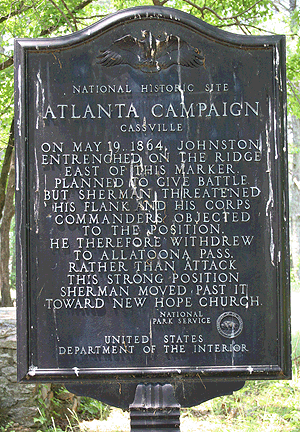 |
Union troops swarm the streets of Cassville. Artillery shells thrown from Federal batteries positioned at the Cassville Female College shriek overhead. Some fall short and damage buildings. One firey ball leaves a reverberating crack in the steeple bell of the Cassville Methodist Church. The Yankees set fire to a home and one or two buildings.
The armies shoot at each other all day until 4 p.m. when Federals advancing from several directions pressure the Army of Tennessee to fall back to a ridge southeast of town. In the Confederate's new position, Sam and Tom Pittard and Turner’s Battery are with Gen. Hardee’s Corps on the left or southernmost defenses. Their worst fears have come true. Their families and friends have fled to the safety of the woods and the thunderous crack of cannon fire shakes their very homes. Yankee artillery tears through the Confederate line making it impossible to hold the position. After dark, the Southerners slip away and cross the Etowah River. Sheman doesn't pursue but camps three days before heading west. They will meet again in thick woods near Dallas, GA.
Militarily, Cassville was of no strategic importance for the South but the confusion of May 19, 1864 stirred bitter debate among Confederate brass for years afterwards. Its citizens never forgave Johnston for abandoning Cassville to the Yankees, however, bitter feelings over Sherman’s deeds later in the war would eclipse the ill will stunned citizens felt for the Army of Tennessee's commander. The Confederate retreat left the door wide open for Union occupation of Cassville and Bartow County. Though most citizens fled south as the armies approached and never returned, our family - the Leaks and Carlisles in Adairsville, the Thompsons in Pine Log, and the Dillards and Pittards literally on the battlefields east of Cassville - all remained (a Sarrett doesn't arrive in the area for another 20 years).
|
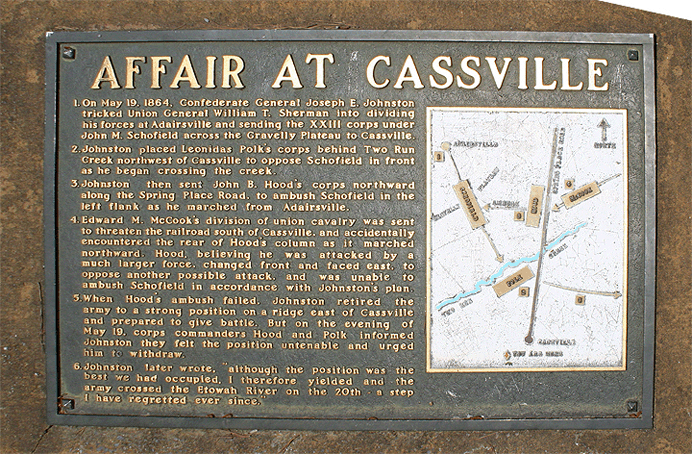 |
Pickett's Mill near Dallas, GA...May 27, 1864.. “(Capt. William B.) Turner had been with Cheatham for several days, but at this place was sent to (Gen. Leondias) Polk at his (Polk’s) particular request and having been put in a position on Featherstone’s brigade to endeavor to silence two of the enemies’ batteries had one piece disabled and six or eight men badly wounded. Two afterwards died." Colonel Melancthon Smith, Confederate Gen. William J. Hardee’s chief of artillery.
Kennesaw Mountain...June 27, 1864...
Vinings Station...July 3, 1864...While factions of the two armies clash between what is now Concord Rd. and South Cobb Dr. in Smyrna, GA near Ruff's Mill and the Concord Rd. covered bridge, Cheatham's Division including Turner's Battery move on a few miles further south to Vinings Station.
Atlanta...
Jonesboro...
Columbus, MS...“(Sam) was taken sick at Columbus, MS in 1864. He was sent home to Bartow County, GA on sick furlough. He was sick for a long time and was never able for service any more, which condition was shown by a physician’s certificate.” Statement submitted as part of Margaret's Widow's Pension Application in 1919 given by W.R. Ward, former private in Turner's Mississippi Battery.
Nashville, TN...Dec 16, 1864...Both Pvt. Thomas Pittard and Cpl. James R. Pittard are captured when Turner's Battery is overrun at Compton's Hill (later renamed Shy's Hill) during the Battle of Nashville. Thomas is released from Camp Chase, OH Prison March 16, 1865 after taking the oath of allegiance to the United States.
History of Bartow County by Cunyus published in 1939 incorrectly states that brothers Samuel and Thomas Pittard and one of Thomas' sons, who would have been only four years old at the time, all served in Wheeler’s Confederate Cavalry.
- The Courant-American, Cartersville, Bartow County, GA, Thursday, Jan 8, 1891,
Cass Station.
Mrs. Mattie Crenshaw died at the home of her father, Mr. Sam Pittard, near Grassdale, Saturday morning. Her remains were interred in the Cassville cemetery Sunday afternoon, Rev. B.B. Quillian conducting the services. A very large number of sorrowing relatives and friends witnessed the last sad rites. Mrs. Crenshaw had been married about four years. Her home was in Griffin, where her husband holds a government position.
The Pittard family had a family reunion Christmas and Mr. and Mrs. Crenshaw came up to participate. She contracted a case of measles and her condition grew worse, and on Saturday morning her spirit passed from this world into the sweet rest beyond.
She was a member of the Baptist church and was beloved by many for her kind and sunny disposition. The grief stricken husband and other relatives have the profound sympathy of all.
-
-
- Samuel died May 23, 1900 and is buried in Cassville Cemetery. County records show the will listed four of his five surviving children, all except our grandmother, Bettie, and was recorded Sept 17, 1900. His wife, Margaret, was executor. After Samuel died in 1900, Bettie and George M. Sarrett and their children, Cliff and Mattie, lived with Margaret on the old Grassdale homestead.
The Cartersville News, Cartersville, Bartow County GA, Dec 17, 1908
"The Bartow County Chapter of the Daughters of the Confederacy commissioned a monument to Bartow Confederate soldiers which was unveiled December 8, 1908 in a patriotic ceremony in Cartersville.
The Daughters, remaining Bartow Civil War veterans -- each pinned with a rosette of red and white ribbon --, school children, and citizens marched to the monument site where local and war dignitaries gave speeches. At the appointed time, Mrs. Lily Johnson Bradley, chosen by the Daughters for the honor, pulled away the covering to unveil the monument. The band struck up 'Dixie' and a great cheer from the assemblage rent the air.
The Daughters paid McNeil Marble Co. in Marietta GA $2,000 for the five-section, 30 foot-high monument."
In 1919, Margaret applied for a Widow's Pension in Bartow County GA for Sam's service in both the 40th Georgia Infantry Regiment and Turner's Mississippi Light Artillery. The application required that Margaret go before the County Ordinary to prove her identity and right to apply for the pension through a lengthy list of questions about her husband's military service and whereabouts during the war. Sworn statements by Charles M. Culver, a life-long Bartow County resident and fellow infantryman in the 40th Georgia, and W. R. Ward, who served in Turner's Battery, are included in the application.
|
|
Children of Margaret Dillard and Samuel LaFayette Pittard:
|
|
|
1. Martha L. "Mattie" b. Sep 9, 1859, Bartow County GA, m. Edward P. Crenshaw Feb 6, 1887 Bartow County GA, d. Jan 3, 1891, buried Cassville Cemetery, Bartow County GA. Teaching school in Goldville (now Joanna), SC in 1884. May have been named for grandmothers Martha Lofton Dalrymple Dillard and Curacy Louisa Pittard.
|
|
|
2. William Davis "Dave" b. Dec 20, 1861 Bartow County GA, m. Cynthia A. Myers Dec 22, 1885 Bartow County GA, d. 1945, buried Cassville Cemetery, Bartow County GA. Operated a general store in Cassville along with his son, Sam.
|
|
|
3. James Dillard "Jim" b. Feb 25, 1867 Bartow County GA, m. 1st Ovelene "Ovie" Layton Dec 16, 1895, m. 2nd Ollie Strozier abt 1908, d. 1933, buried Cassville Cemetery, Bartow County GA. Elected Bartow County tax collector.
|
|
|
4. Elizabeth Frances "Bettie" b. Sep 6, 1869, Bartow County GA, m. George Montgomery Sarrett, Oct 10 1888, Bartow County GA, d. Nov 11, 1950, State Hospital, Milledgeville, Baldwin County, GA, buried Cassville Cemetery, Bartow County GA.
|
|
|
5. Caroline Sullivan "Carrie" b. abt 1871 Bartow County GA, m. Robert Eugene Wilson, M.D. Jan 15, 1896, Bartow County GA, d. ?.
|
|
|
6. Henry Connor "Connor" b. Oct 29, 1878 Bartow County GA, m. Mamie Dunlop Smith May 28, 1908 in Bartow County GA, d. Aug 1967 Bartow County, GA, buried ?. |
|